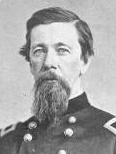 Open main menu
Open main menu
 Open main menu
Open main menu

Alfred Sully
(1820 - 1879)
Home State: Iowa
Education: US Military Academy, West Point, NY, Class of 1841
Command Billet: Commanding Regiment
Branch of Service: Infantry
Unit: 1st Minnesota Infantry
see his Battle Report
Before Antietam
Alfred Sully, son of Thomas Sully the portrait painter, graduated from West Point in 1841 and was commissioned a 2nd Lieutenant in the 2d United States Infantry. He spent a year at Fort Russell in Florida fighting the Seminole Indians before being assigned to Madison Barracks, Sackett's Harbor, New York from 1842-46. He joined the American forces in Mexico in time to participate in the siege of Vera Cruz. In 1847 Sully was promoted to First Lieutenant.
In 1848 the 2nd US Infantry was ordered to California and stationed first in Monterey and then Benicia. Sully, by then quartermaster and a Captain, participated in Indian campaigns in northern California and southern Oregon.
From 1854 to 1861 Sully served on the northern plains where he encountered the Northern Cheyenne and Sioux. He commanded troops in the Dakota and Nebraska Territories near Fort Pierre, Fort Kearney, and Fort Ridgely, Minnesota. In 1861 he was ordered to Fort Leavenworth, Kansas, to recruit forces for the Union and to drive the rebels out of St. Joseph and Independence, Missouri. He was commissioned Colonel of the First Minnesota Volunteers in February 1862 and led them on the Peninsula Campaign in Virginia.
On the Campaign
He commanded his regiment on the Maryland Campaign.
The rest of the War
He was appointed Brigadier General, US Volunteers on 26 September 1862 and commanded a brigade at Fredericksburg. He was relieved of command in May 1863 and sent west, back on the plains serving under General Pope. From 1863 to 1866 he commanded the "North Western Indian Expeditions" directed against the Arapaho, Sioux, and Cheyenne. The battles of White Stone Hills and Tah-kah-ha-kuty (or Killdeer Mountain) proved Sully's skill as an Indian fighter, and when the Congressional Joint Special Committee to Inquire into the Condition of the Indian Tribes, often referred to as the Doolittle committee, came west, Sully was asked to testify.
After the War
In 1866 Sully mustered out of the Volunteers and returned to the regular army with the rank of Lieutenant Colonel. He spent his last years serving on various special projects. He chaired a commission to investigate the Fetterman Massacre at Fort Kearney and to establish peace with the Indians of the Powder River country. In 1869 he became Superintendent of Indians for the Territory of Montana and in 1877 served briefly with General Howard in the Nez Perce war. Alfred Sully died in 1879 at Fort Vancouver, Washington Territory.
More on the Web
Basic Bio information gleaned from the Iowa in the CW (www.iowa-counties.com site gone 12/2003) site. His gravesite is on Findagrave. His picture from a photograph at the Minnesota Historical Society.
He married Manuela Antonia Jimeno (1833-1851) in 1850 they had a son in 1851. Both mother and child died that year. He married again, Susan Pehandutawin Red Heron Woman (1838-1909) in about 1857 and they had a daughter Mary. He married for the third time, Sophia Henrietta Webster (1837-1898) in April 1869 and they had 2 children.
Birth
05/22/1820; Philadelphia, PA
Death
04/27/1879; Vancouver, WA; burial in Laurel Hill Cemetery, Philadelphia, PA